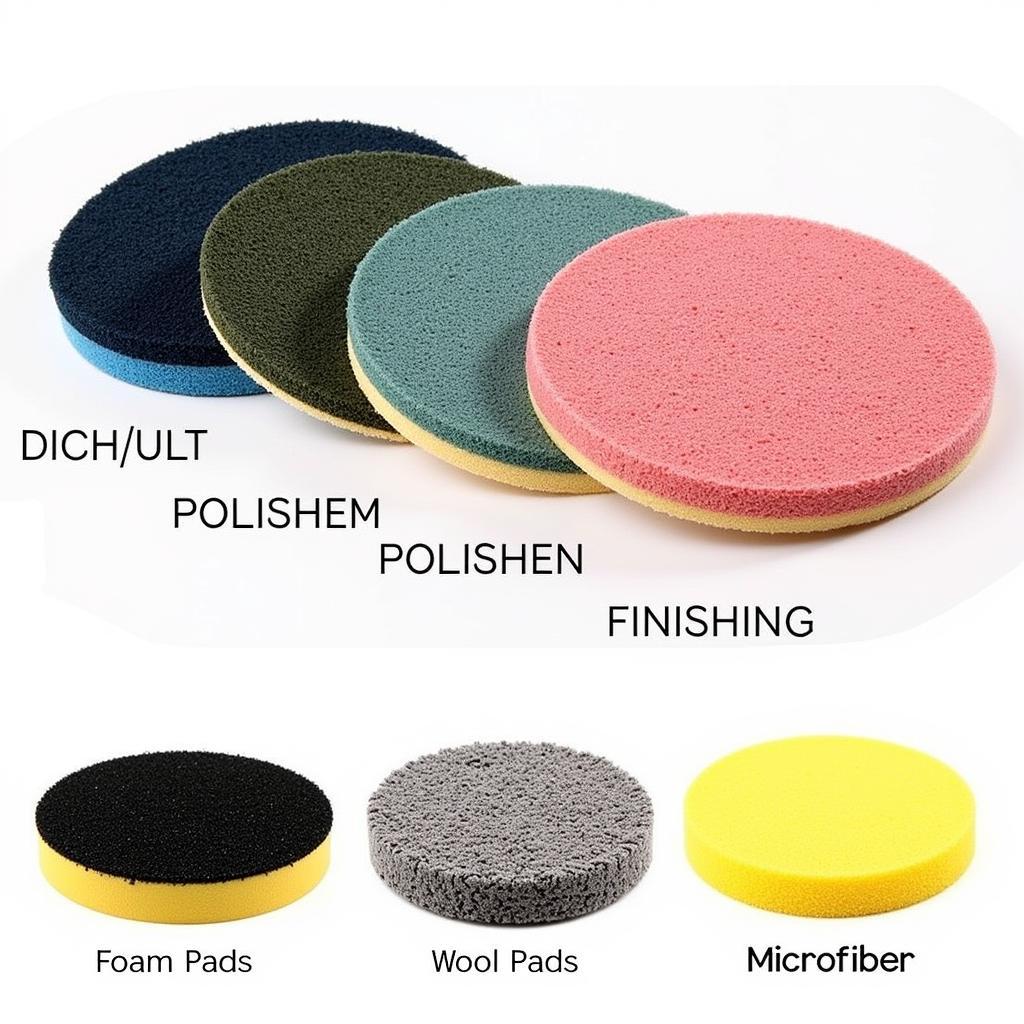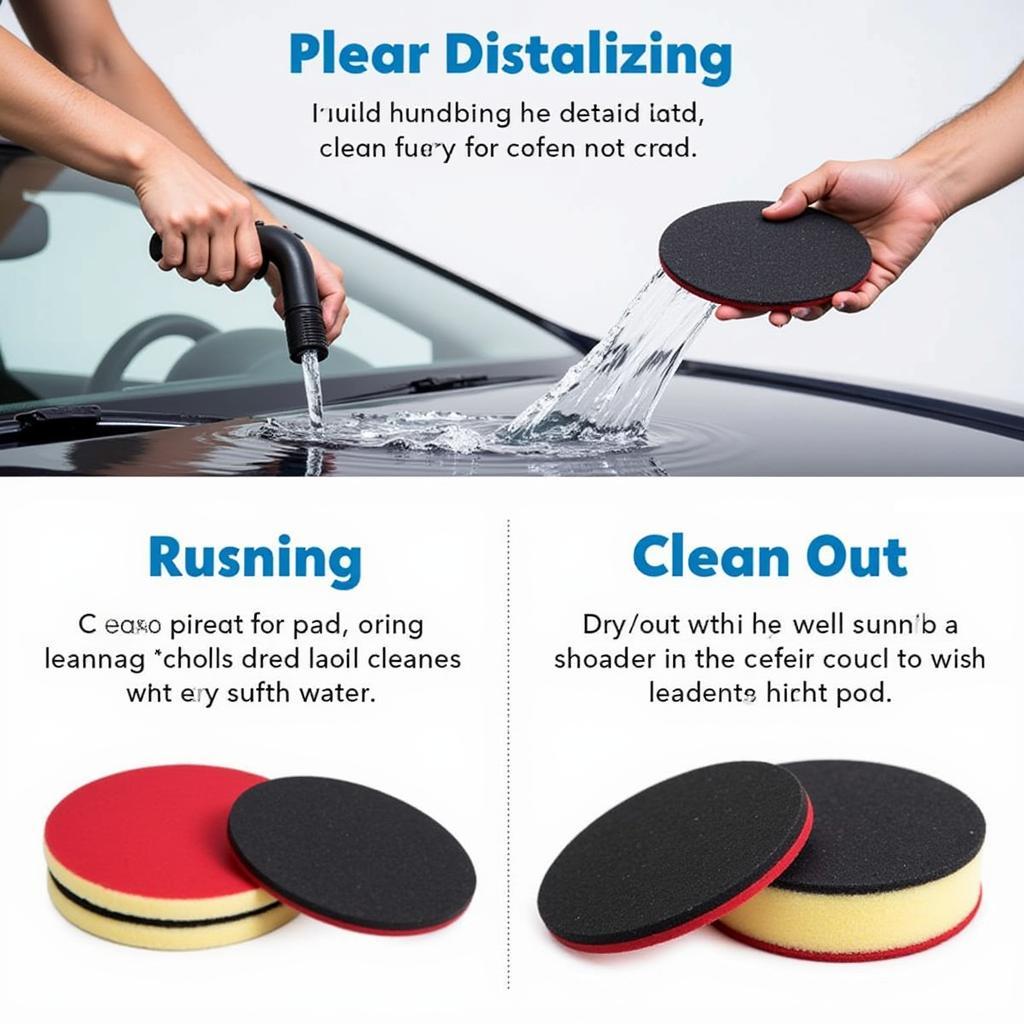Achieving a showroom-worthy shine on your car requires more than just a quick wash and wax. It demands attention to detail, the right products, and crucially, the Best Buffing Pads For Car Detailing. These often-overlooked tools are the key to unlocking a truly professional finish, whether you’re removing swirl marks, restoring faded paint, or applying a final polish.
Why Buffing Pads Matter
Think of buffing pads as the intermediaries between your car’s paint and the polish or compound. They distribute pressure evenly, preventing uneven results and potential damage to the clear coat. The wrong pad can lead to swirl marks, holograms, or even burn through the paint, especially when using a high-speed polisher.
Decoding the World of Buffing Pads
Navigating the vast market of buffing pads can feel overwhelming. Here’s a breakdown to simplify your search:
Material Matters
-
Foam: The most common type, foam pads offer a good balance of cutting and finishing capabilities. They come in various densities:
- Cutting Pads (Heavy Cut): These dense pads are your go-to for removing heavy scratches, swirl marks, and oxidation. They’re more aggressive, so use them with caution.
- Polishing Pads (Medium Cut): Offering a balance of correction and refinement, these pads work well for removing light to medium imperfections and enhancing gloss.
- Finishing Pads (Fine Cut): These soft pads are designed for applying waxes, sealants, and the final polish to achieve that mirror-like shine.
-
Wool: Wool pads offer the most aggressive cut, ideal for heavily oxidized or scratched paint. However, they generate more heat and require careful handling to avoid damaging the paint.
-
Microfiber: These pads are known for their cutting power and ability to hold more product than foam. They are suitable for both cutting and polishing stages but require proper cleaning and maintenance.
 Different Types of Car Buffing Pads
Different Types of Car Buffing Pads
Size and Shape: It’s All in the Details
Buffing pads come in various sizes, with the most common being 3″, 5.5″, and 6.5″. Smaller pads provide more control in tight areas, while larger pads cover more surface area, speeding up the process. The shape of the pad also plays a role. Round pads are versatile, while hex-logic pads offer better cooling and product distribution.
Choosing the Right Pad for the Job
Selecting the best buffing pad depends on several factors:
- Severity of Imperfections: Deep scratches require a more aggressive pad (cutting foam or wool), while light swirls might only need a polishing pad.
- Paint Hardness: Harder paints can withstand more aggressive pads, while softer paints require a gentler approach.
- Type of Polish/Compound: Always choose a pad compatible with your chosen product. Some products work best with specific pad materials.
Expert Insight:
“Remember, it’s always better to start with a less aggressive pad and work your way up if needed,” advises master detailer, John Smith of Detailing Dynamics. “This minimizes the risk of unnecessary paint removal and ensures a more controlled approach.”
Maintaining Your Buffing Pads for Long-Lasting Performance
Proper care extends the life of your buffing pads and ensures optimal performance:
- Clean After Each Use: Remove excess product and paint residue by thoroughly washing the pads with dedicated pad cleaner or mild soap and water.
- Air Dry Completely: Allow pads to air dry naturally before storing them in a cool, dry place.
- Inspect Regularly: Check for signs of wear and tear, such as excessive matting, tearing, or loss of shape. Replace worn pads to avoid damaging your car’s paint.
Conclusion
Selecting the best buffing pads for car detailing is crucial for achieving professional-level results. By understanding the different types of pads, their strengths, and how to choose the right one for your needs, you can achieve a flawless, mirror-like finish on your car. Remember, proper maintenance is key to maximizing the lifespan of your pads and ensuring consistent results over time.
FAQs
1. Can I use the same buffing pad for different colors of cars?
It’s best practice to use separate pads for light and dark-colored cars. This prevents any potential cross-contamination of polish or paint residue, which can be noticeable on contrasting paint finishes.
2. How often should I replace my buffing pads?
Pad lifespan varies depending on usage and care. However, it’s generally recommended to replace foam pads after 10-15 uses, wool pads after 5-7 uses, and microfiber pads after 20-25 uses or sooner if you notice excessive wear and tear.
3. Can I use a household drill as a car polisher?
While it’s technically possible, it’s not recommended. Household drills lack the speed control and ergonomic design of dedicated car polishers, increasing the risk of uneven results and potential damage to your car’s paint.
 Maintaining Car Detailing Buffing Pads
Maintaining Car Detailing Buffing Pads
Need help with your car detailing project? Contact us via WhatsApp: +1(641)206-8880 or Email: [email protected]. Our 24/7 customer support team is ready to assist you. You can also find more car detailing tips and product reviews on our website, CarDetailingUK. Check out our articles on the best dia buffing pads for car detailing, the best detail cloth for cars, or find the best car detailing shop in San Francisco. For those looking for a complete solution, we have reviewed the best car detailing kit 2020 and the best equipment for car detailing.

Leave a Reply